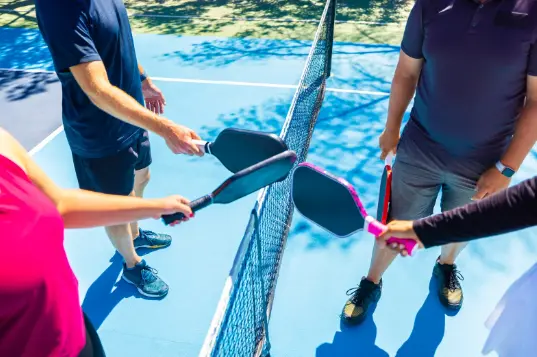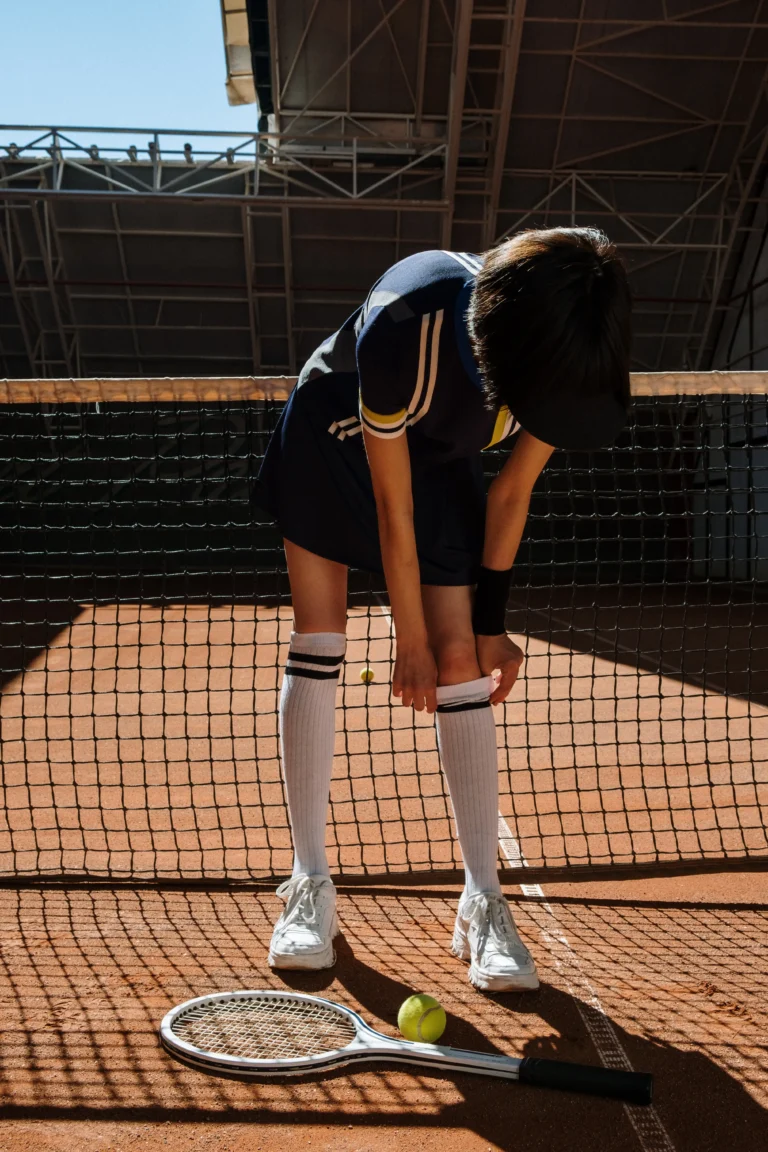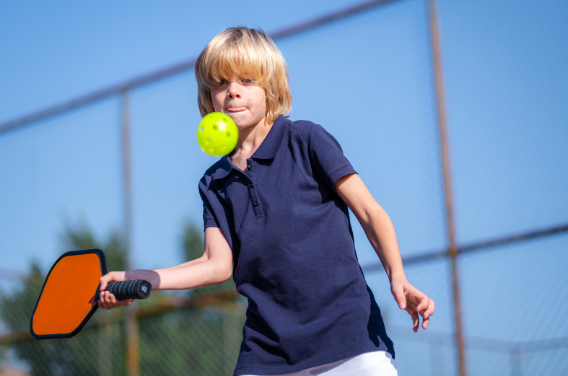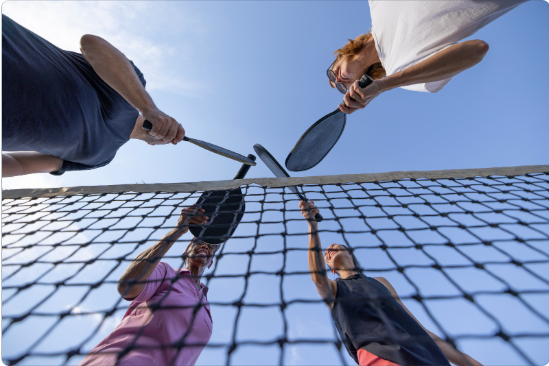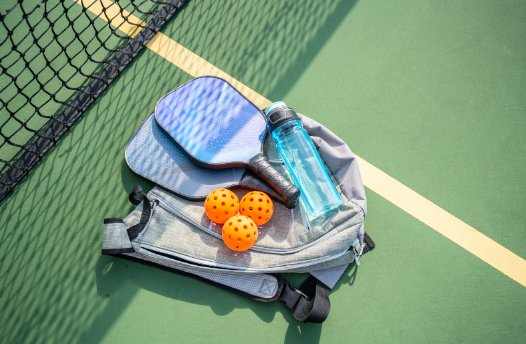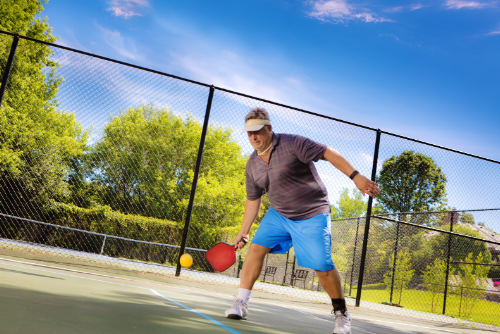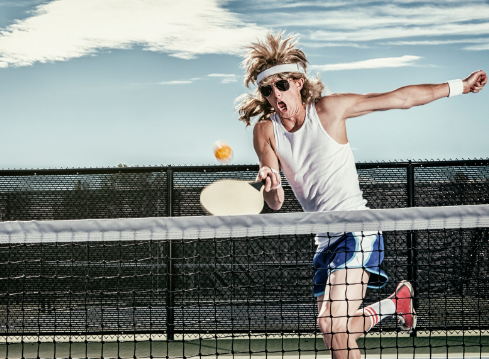Speak the Language: Common Pickleball Terminology Defined
Pickleball, a sport that ingeniously blends elements of tennis, badminton, and ping-pong, has rapidly ascended in popularity, captivating players of all ages worldwide. Characterized by its unique combination of simplicity and strategic depth, pickleball is attracting a growing community of enthusiasts. Essential to immersing oneself in the game, and often overlooked, is the mastery of its specific terminology. Common Pickleball Terminology Defined From ‘dink’ to ‘volley’, understanding these terms not only enhances your gameplay but also fosters a deeper connection with the pickleball community. This guide aims to demystify the language of pickleball, making the sport more accessible and enjoyable for everyone, whether you’re a beginner or an experienced player.
The Basics of Pickleball Terms
In pickleball, mastering the lingo is as important as nailing the gameplay. Let’s start with some fundamental terms:
- Serve: The game begins with a serve. This underhand stroke sends the ball diagonally across the court into the opponent’s service box. The serve must clear the non-volley zone, commonly known as the kitchen, and cannot bounce before reaching the receiver. A unique aspect of pickleball is that serves must be made below the waist level.
- Volley: A volley is hitting the ball before it bounces on the ground. In pickleball, volleys are integral in fast-paced exchanges near the net. However, they are not allowed within the non-volley zone to prevent aggressive over-net play.
- Fault: A fault in pickleball is any action that stops play due to a rule violation. This includes hitting the ball out of bounds, not clearing the net, stepping into the non-volley zone while volleying, and serving or receiving faults.
- Scoring System: Pickleball uses a unique scoring system where only the serving side can score points. A typical game is played to 11 points, and a team or player must win by a 2-point margin.
- Side Out: This term is used when the serve is passed to the opposing team due to a fault by the serving team. It signifies a change in serve possession and is a critical moment in game strategy.
The Court and Its Components
A pickleball court is a symphony of lines and zones, each with a specific purpose and set of rules. Understanding these components is crucial for both playing and strategizing.
- Baselines: The baselines run parallel to the net at the furthest ends of the court. In pickleball, the baseline is crucial for serving, as the serve must be initiated behind this line. It’s also a reference point for players during baseline rallies.
- Non-volley Zone (Kitchen): Perhaps the most distinctive feature of a pickleball court, the ‘kitchen’ is a 7-foot zone on either side of the net. Players are prohibited from volleying the ball within this area. This rule prevents players from executing smashes right at the net, thereby adding a strategic depth to the game. The non-volley zone demands skill in executing gentle ‘dinks’ and precise shot placement.
- Service Areas: The court is divided into two service areas on each side. These rectangular areas are where players serve to and receive serves. A serve must land in the diagonal opposite service area. The service areas are also important during rallies as players strategize to position themselves and direct shots.
- Sidelines: These lines run perpendicular to the net and mark the lateral boundaries of the court. A ball landing outside these lines is out of bounds.
- Centerline: This line divides the service areas into left and right on each side of the court. It’s important for doubles play, indicating which player should receive the ball.
Understanding the layout and terminology of the pickleball court is essential not just for rule adherence but also for developing effective gameplay strategies. Whether positioning for a serve, a volley, or a strategic dink, each component of the court plays a role in how the game unfolds.
Playing Techniques and Shots
In pickleball, various shots and techniques are employed to outmaneuver opponents. Understanding these can significantly enhance your gameplay.
- Dink: The dink is a soft shot played just over the net into the opponent’s non-volley zone (kitchen). It’s a finesse shot that requires control rather than power, used to draw opponents closer to the net and create opportunities for harder shots.
- Groundstroke: Groundstrokes are shots hit after the ball has bounced. They can be executed from the baseline or mid-court and are fundamental in setting up offensive plays or defending against the opponent’s shots.
- Lob: A lob is a high-arcing shot intended to pass over the opponent and land in the back of the court. It’s used to move opponents away from the net, creating space for subsequent shots. Lobs require precision, as a poorly executed lob can be easily smashed by an opponent.
- Smash: A smash is a powerful, overhead shot, typically used to forcefully return a high ball from the opponent. It’s an aggressive move that, when executed correctly, can be difficult to defend.
- Stacking: In doubles, stacking is a strategic positioning where both players stand on the same side of the court before the serve. This allows players to maintain their forehand shots in the center of the court, which is often advantageous.
- Erne: The Erne is a dynamic move where a player jumps from outside the non-volley zone to hit a volley, landing outside the zone. It’s a legal maneuver used to surprise opponents and hit an aggressive shot close to the net without committing a fault in the kitchen.
Mastering these shots and techniques is key to advancing in pickleball, offering a diverse range of tactical options during play. Each shot has its place and time, and knowing when and how to use them can give you a significant edge on the court.
Gameplay Strategies
n pickleball, strategic gameplay is as crucial as technical skill. Two pivotal terms in this regard are ‘Third Shot Drop’ and ‘Drive’, each representing a different style of play.
- Third Shot Drop: This is a key shot in transitioning from defense to offense. After the serve and return, the serving team usually performs the third shot drop. It’s a soft, arcing shot aimed to land in the opponent’s non-volley zone (kitchen), forcing them to hit upwards and allowing the serving team to move forward and take control of the net.
- Drive: In contrast to the third shot drop, a drive is a hard, flat shot directed toward the opponents. It’s an aggressive, offensive play that keeps the ball low and fast, making it difficult for the opponent to return with a volley. Drives can be used to overpower opponents or as a setup for a winning shot.
Defensive play in pickleball often involves patiently waiting for the opponent to make an error, using shots like dinks and third shot drops. In contrast, offensive play involves more aggressive tactics like drives and smashes, aiming to seize control of the point. Both play styles require a deep understanding of the game’s dynamics, including when to employ each strategy for maximum effectiveness.
Rules and Regulations
Pickleball, while fun and engaging, has specific rules that ensure fair play and competitive balance. Two fundamental rules are the ‘Double Bounce Rule’ and the ‘No-Volley Zone Rule’.
- Double Bounce Rule: This rule is integral to pickleball’s playstyle. After the serve, the ball must bounce once in the receiver’s area, and then once in the server’s area before it can be volleyed (hit without a bounce). This rule prevents players from aggressively attacking serves and returns, promoting a more strategic game.
- No-Volley Zone Rule (Kitchen Rule): Players are prohibited from volleying (hitting the ball before it bounces) while standing in the non-volley zone, commonly referred to as the kitchen. This area extends seven feet from the net on both sides. The rule encourages a variety of shots and strategies, preventing the game from being dominated by aggressive net play.
Line calls and refereeing are critical in maintaining the integrity of the game.
- Line Calls: In pickleball, balls must land within the court’s boundary lines to be considered ‘in’. Players often make line calls on whether the ball landed in or out. In informal play, this relies on honesty and sportsmanship.
- Refereeing: In more formal or competitive play, referees oversee the game, making crucial calls and ensuring adherence to rules. Their presence is essential in maintaining order and fairness, especially in tournaments where stakes and competitive spirits are high.
Understanding and respecting these rules and regulations is essential for all players, ensuring a fair, enjoyable, and competitive experience in the game of pickleball.
Pickleball Culture and Slang
Pickleball isn’t just a sport; it’s a culture enriched with its own vernacular and social dynamics. This unique blend of informal terms and slang adds to the game’s communal and inclusive spirit.
- “Dinking Duel”: A light-hearted term for a series of soft shots (dinks) exchanged between players at the net, often testing patience and precision.
- “Kitchen Camping”: Refers to players spending too much time in the non-volley zone or ‘kitchen’, usually waiting to pounce on a good shot.
- “Banger”: A player who frequently uses powerful, aggressive shots, often preferring drives over soft play.
The social aspect of pickleball is integral. It’s common for players to gather not just for the sport but for the camaraderie it fosters. This social interaction leads to the creation of unique slang, which becomes part of the collective pickleball experience. These terms, often born out of humorous in-game scenarios or shared experiences, add a layer of community bonding to the game. The culture of pickleball, thus, transcends the court, cultivating a sense of belonging and togetherness among players, enriching the game far beyond its physical play.
Conclusion
Understanding the unique terminology of pickleball is key to fully appreciating and engaging with the sport. Familiarity with terms like ‘dink’, ‘third shot drop’, and the playful slang unique to the game not only enriches your playing strategy but also deepens your connection with the pickleball community. As you step onto the court armed with this newfound linguistic arsenal, you’ll find yourself more confident in your gameplay and more integrated within the social fabric of pickleball. Embrace these terms and let them guide your journey in this dynamic sport, enhancing both your performance and your enjoyment of the ever-growing and vibrant world of pickleball.

